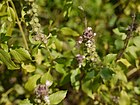Note: This is a project under development. The articles on this wiki are just being initiated and broadly incomplete. You can Help creating new pages.
Difference between revisions of "Ocimum kilimandscharicum"
| (One intermediate revision by the same user not shown) | |||
| Line 1: | Line 1: | ||
| − | + | [[File:Ocimum ¿ kilimandscharicum ? (6674301537).jpg|thumb|right]] | |
| + | '''Ocimum kilimandscharicum''' is a perennial plant growing 1 - 2 metres tall. The plant is often grown as an annual, especially in cooler climates. The leaves are used as a flavouring in foods, whilst the plant also has medicinal properties, yields an essential oil, and is used as an insect repellent. | ||
==Uses== | ==Uses== | ||
| − | {{Uses| | + | {{Uses|Lower fevers}}.<ref name="Uses"/> |
==Parts Used== | ==Parts Used== | ||
| − | {{Parts Used| | + | {{Parts Used|Leaves}}. |
==Chemical Composition== | ==Chemical Composition== | ||
| − | <ref name="chemical composition"/> | + | It contains two new compounds with damarane skeleton namely 2α-hydroxy-3-oxodammara-20,24-diene (1) and 2α,3β-dihydroxy dammara-20, 24-diene (2) together with apeginin7-O-neohespeiridoside.<ref name="chemical composition"/> |
==Common names== | ==Common names== | ||
| Line 16: | Line 17: | ||
===Dravya=== | ===Dravya=== | ||
===Rasa=== | ===Rasa=== | ||
| − | |||
===Guna=== | ===Guna=== | ||
| Line 29: | Line 29: | ||
==Habit== | ==Habit== | ||
| − | {{Habit|}} | + | {{Habit|Perennial}} |
==Identification== | ==Identification== | ||
| Line 48: | Line 48: | ||
==Mode of Propagation== | ==Mode of Propagation== | ||
| − | {{Propagation|}} | + | {{Propagation|Seeds}} |
==How to plant/cultivate== | ==How to plant/cultivate== | ||
| − | <ref name="How to plant/cultivate"/> | + | Prefers a rich, light, well-drained to dry soil and a position in full sun.<ref name="How to plant/cultivate"/> |
==Commonly seen growing in areas== | ==Commonly seen growing in areas== | ||
| Line 58: | Line 58: | ||
==Photo Gallery== | ==Photo Gallery== | ||
<gallery class="left" caption="" widths="140px" heights="140px"> | <gallery class="left" caption="" widths="140px" heights="140px"> | ||
| − | + | File:Ocimum ¿ kilimandscharicum ? (6674314583).jpg | |
| + | File:Ocimum ¿ kilimandscharicum ? (6674295441).jpg | ||
| + | File:Ocimum ¿ kilimandscharicum ? (6674307993).jpg | ||
| + | File:Ocimum ¿ kilimandscharicum ? (6674301537).jpg | ||
</gallery> | </gallery> | ||
| Line 64: | Line 67: | ||
<references> | <references> | ||
| − | <ref name="chemical composition">[ | + | <ref name="chemical composition">[https://www.ajol.info/index.php/bcse/article/view/191196#:~:text=Two%20new%20compounds%20with%20damarane,)%2C%20%CE%B1%2Damyrin%20acetate%20( Chemistry]</ref> |
| − | <ref name="Leaf">[ | + | <ref name="Leaf">[Morphology]</ref> |
| − | <ref name="How to plant/cultivate">[ | + | <ref name="How to plant/cultivate">[http://tropical.theferns.info/viewtropical.php?id=Ocimum+kilimandscharicum Cultivation]</ref> |
<ref name="Uses">Indian Medicinal Plants by C.P.Khare</ref> | <ref name="Uses">Indian Medicinal Plants by C.P.Khare</ref> | ||
</references> | </references> | ||
==External Links== | ==External Links== | ||
| − | * [ ] | + | * [https://journals.plos.org/plosone/article?id=10.1371/journal.pone.0104377 Ocimum kilimandscharicum on journals.plos.org] |
| − | * [ ] | + | * [https://www.infonet-biovision.org/PlantHealth/MedicinalPlants/Ocimum-kilimandscharicum Ocimum kilimandscharicum on www.infonet-biovision.org] |
| − | + | ||
[[Category:Herbs]] | [[Category:Herbs]] | ||
[[Category:Pages without herbs images]] | [[Category:Pages without herbs images]] | ||
Latest revision as of 17:05, 8 June 2020
Ocimum kilimandscharicum is a perennial plant growing 1 - 2 metres tall. The plant is often grown as an annual, especially in cooler climates. The leaves are used as a flavouring in foods, whilst the plant also has medicinal properties, yields an essential oil, and is used as an insect repellent.
Contents
- 1 Uses
- 2 Parts Used
- 3 Chemical Composition
- 4 Common names
- 5 Properties
- 6 Habit
- 7 Identification
- 8 List of Ayurvedic medicine in which the herb is used
- 9 Where to get the saplings
- 10 Mode of Propagation
- 11 How to plant/cultivate
- 12 Commonly seen growing in areas
- 13 Photo Gallery
- 14 References
- 15 External Links
Uses
Parts Used
Chemical Composition
It contains two new compounds with damarane skeleton namely 2α-hydroxy-3-oxodammara-20,24-diene (1) and 2α,3β-dihydroxy dammara-20, 24-diene (2) together with apeginin7-O-neohespeiridoside.[2]
Common names
| Language | Common name |
|---|---|
| Kannada | |
| Hindi | |
| Malayalam | |
| Tamil | |
| Telugu | |
| Marathi | |
| Gujarathi | |
| Punjabi | |
| Kashmiri | |
| Sanskrit | |
| English |
Properties
Reference: Dravya - Substance, Rasa - Taste, Guna - Qualities, Veerya - Potency, Vipaka - Post-digesion effect, Karma - Pharmacological activity, Prabhava - Therepeutics.
Dravya
Rasa
Guna
Veerya
Vipaka
Karma
Prabhava
Habit
Identification
Leaf
| Kind | Shape | Feature |
|---|---|---|
Flower
| Type | Size | Color and composition | Stamen | More information |
|---|---|---|---|---|
| {{{5}}} |
Fruit
| Type | Size | Mass | Appearance | Seeds | More information |
|---|---|---|---|---|---|
Other features
List of Ayurvedic medicine in which the herb is used
Where to get the saplings
Mode of Propagation
How to plant/cultivate
Prefers a rich, light, well-drained to dry soil and a position in full sun.[4]
Commonly seen growing in areas
[[:Category:Herbs that are commonly seen in the region of |]], [[:Category:Herbs that are commonly seen in the region of |]], [[:Category:Herbs that are commonly seen in the region of |]], [[:Category:Herbs that are commonly seen in the region of |]], [[:Category:Herbs that are commonly seen in the region of |]].




